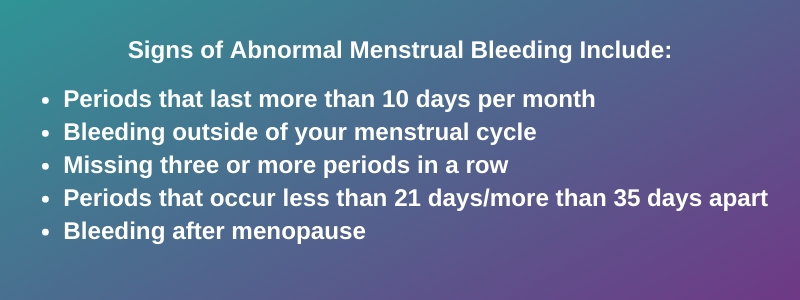
Have you been ignoring fibroid symptoms — such as heavy periods, pelvic pain, or frequent urination? While you may think it’s no big deal to ignore these issues, you should be aware that these can indicate uterine fibroids. Fibroids are a type of common, non-cancerous growth in the uterus or on the uterine walls. Fibroids untreated have the potential to harm surrounding organs, impact fertility, and cause painful or uncomfortable symptoms. Beyond that, many fibroid symptoms can also be indicative of other uterine or reproductive conditions — some of which may be far more serious than fibroids.
While ignoring fibroid symptoms may be tempting for a variety of reasons, we recommend taking control of the situation and consulting your medical provider for a proper medical diagnosis and appropriate treatment plan.
Why We Ignore Fibroid Symptoms
-
“I’m too busy to deal with it right now.”
We get it. Up to 80% of women develop fibroids before the age of 50. We understand that many are delicately balancing career and family responsibilities, fitting time in for exercise, leisure, and everything else. Taking time out for treatment — or even just to schedule a doctor appointment — may feel overwhelming.
However, it’s common for those with fibroid symptoms to regularly call in sick to work, cancel social plans, or avoid sex with their partner. If your symptoms interfere with your life or self-esteem, it can be a major inconvenience.
We recommend finding the time to learn about fibroid treatment options, especially since some of them are not as time-consuming as you might think. After treatment, you can rediscover a more productive life without pain, heavy periods, or other undesirable fibroid symptoms.
Life After Uterine Fibroid Embolization
-
“I just don’t want to have surgery.”
Of course not — who does?! But here’s the thing: While many believe that the only available treatment for fibroids is hysterectomy — the surgical removal of the uterus — that actually isn’t true. In fact, our fibroid experts want you to avoid unnecessary surgery and instead consider an effective, non-surgical treatment called Uterine Fibroid Embolization (UFE). UFE is lower risk, allows you to keep your uterus, and involves a shorter, less painful recovery than hysterectomy.
Hysterectomy vs. Uterine Fibroid Embolization
-
“My menstrual flow is normal.”
Are you sure? Heavy, lengthy periods are a common complaint from people with fibroids, but it can be challenging to compare periods with others to determine what constitutes ‘normal’. If you are experiencing severe menstrual bleeding that impacts your daily life — such as constantly bleeding through sanitary products in a short amount of time — we want you to understand that this is not typical. We also want you to know there’s help available.

-
“Everyone has back pain, right?”
Back pain, most often associated with muscle or ligament strains, is indeed an ailment experienced by many people. Although less discussed than some of fibroids’ other effects, back pain is also a common fibroid symptom. Associated pain can radiate from the lower back to the hip, buttock, and down the leg.
If you are swallowing Ibuprofen pills like they are candy in order to alleviate your back pain, it’s probably a good idea to head over to your doctor’s office to see what’s going on. If fibroids are the problem, fibroid treatment may be a better, longer-term solution to address your pain.
Why Fibroids Cause Abdominal, Leg, and Back Pain
-
“I’m too embarrassed to discuss my symptoms with anyone — especially a doctor.”
Let’s face it, some fibroid symptoms can be particularly hard to talk about with others. Embarrassment is often cited as a reason why we ignore fibroid symptoms and avoid medical treatment.
Keep in mind that medical professionals, such as fibroid specialists, are accustomed to discussing these topics on a daily basis and will quickly find ways to put you at ease. Don’t let fibroids untreated cause more problems for your health, reach out to us today to schedule a consultation with a specialist.
10 Questions You Need to Ask Your Doctor About Fibroids
-
“Pelvic exams make me uncomfortable.”
You’re certainly not alone in this, but pelvic exams are nonetheless an essential tool to help maintain good reproductive health. In fact, uterine fibroids are often first discovered on routine pelvic exams. These exams are also used to screen for more serious conditions in which early treatment may be crucial to the best outcomes.
To alleviate any potential discomfort during your exam, we encourage you to communicate openly with your doctor. If you’re uncomfortable doing so, ask around for recommendations for a more understanding provider who you feel you can freely talk to. Pelvic exams should not be painful — so if one is, be sure to speak up.
-
“Because worrying keeps me from finding out what’s wrong.”
Whenever we suspect something with our bodies isn’t quite right, it’s easy to jump to the worst-case conclusion. For many experiencing pelvic-related issues, this may very well be ovarian cancer. You should be aware that while up to 80% of women develop fibroids before the age of 50, the lifetime risk of developing ovarian cancer is only 1 in 78.
Even so, when ignoring fibroid symptoms — or symptoms that you suspect are caused by fibroids — it is important to remember that ovarian cancer is a life-threatening disease that has some of the same symptoms as fibroids. While it isn’t productive to panic, early detection and treatment of ovarian cancer is crucial — so be on the lookout for these common signs of both ovarian cancer and fibroids:
- Abdominal enlargement or bloating
- Pelvic pressure
- Constipation
- Frequent urination
If you are experiencing any of these, be sure to contact your doctor as soon as possible.
Discover Uterine Fibroid Treatment
Although it is easy to come up with reasons why we ignore fibroid symptoms, it is also easy to learn more about fibroid treatment options. At USA Fibroid Centers, our highly-rated specialists perform minimally invasive, non-surgical Uterine Fibroid Embolization in state-of-the-art facilities across the country.
The UFE procedure takes less than an hour and does not require general anesthesia. It is performed under light sedation, so you’ll be comfortable and calm throughout:
- Before the procedure, your fibroids are located using an advanced ultrasound in a process called fibroid mapping.
- After numbing your thigh, one of our specialists makes a small incision which serves as the entry point for a tiny catheter.
- The catheter is threaded into the artery responsible for supplying blood flow to the fibroid.
- Your doctor releases small particles through the catheter to block up this artery.
- Once blood flow is cut off, the fibroid begins to shrink and eventually die.
- Your incision requires no stitches, just a small bandage.
- You should return to your normal, daily activities within one to two weeks.
- Your ovaries and uterus remain intact.
Stop ignoring fibroid symptoms today and instead discover whether you are a candidate for Uterine Fibroid Embolization. Click below to schedule an initial consultation with one of our experts at USA Fibroid Centers — and get back to living your life to its fullest.
Connect with a Fibroid Specialist



